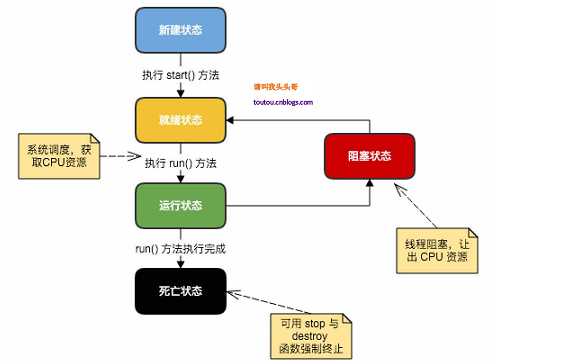标签:操作系统 result hold isp 程序 利用 守护线程 sde dcl
Java给多线程编程提供了内置的支持。一个多线程程序包含两个或多个能并发运行的部分。程序的每一部分都称作一个线程,并且每个线程定义了一个独立的执行路径。
多线程是多任务的一种特别的形式,但多线程使用了更小的资源开销。
这里定义和线程相关的另一个术语 - 进程:一个进程包括由操作系统分配的内存空间,包含一个或多个线程。一个线程不能独立的存在,它必须是进程的一部分。一个进程一直运行,直到所有的非守候线程都结束运行后才能结束。
多线程能满足程序员编写高效率的程序来达到充分利用CPU的目的。
线程经过其生命周期的各个阶段。下图显示了一个线程完整的生命周期。

使用 new 关键字和 Thread 类或其子类建立一个线程对象后,该线程对象就处于新建状态。它保持这个状态直到程序 start() 这个线程。
当线程对象调用了start()方法之后,该线程就进入就绪状态。就绪状态的线程处于就绪队列中,要等待JVM里线程调度器的调度。
如果就绪状态的线程获取 CPU 资源,就可以执行 run(),此时线程便处于运行状态。处于运行状态的线程最为复杂,它可以变为阻塞状态、就绪状态和死亡状态。
如果一个线程执行了sleep(睡眠)、suspend(挂起)等方法,失去所占用资源之后,该线程就从运行状态进入阻塞状态。在睡眠时间已到或获得设备资源后可以重新进入就绪状态。
一个运行状态的线程完成任务或者其他终止条件发生时,该线程就切换到终止状态。
每一个Java线程都有一个优先级,这样有助于操作系统确定线程的调度顺序。
Java线程的优先级是一个整数,其取值范围是1 (Thread.MIN_PRIORITY ) - 10 (Thread.MAX_PRIORITY )。
默认情况下,每一个线程都会分配一个优先级NORM_PRIORITY(5)。
具有较高优先级的线程对程序更重要,并且应该在低优先级的线程之前分配处理器资源。但是,线程优先级不能保证线程执行的顺序,而且非常依赖于平台。
Java提供了两种创建线程方法:
创建一个线程,最简单的方法是创建一个实现Runnable接口的类。
为了实现Runnable,一个类只需要执行一个方法调用run(),声明如下:
publicvoid run()
你可以重写该方法,重要的是理解的run()可以调用其他方法,使用其他类,并声明变量,就像主线程一样。
在创建一个实现Runnable接口的类之后,你可以在类中实例化一个线程对象。
Thread定义了几个构造方法,下面的这个是我们经常使用的:
Thread(Runnable threadOb,String threadName);
这里,threadOb 是一个实现Runnable 接口的类的实例,并且 threadName指定新线程的名字。
新线程创建之后,你调用它的start()方法它才会运行。
void start();
下面是一个创建线程并开始让它执行的实例:
// 创建一个新的线程 class NewThread implements Runnable { Thread t; NewThread() { // 创建第二个新线程 t = new Thread(this, "Demo Thread"); System.out.println("Child thread: " + t); t.start(); // 开始线程 } // 第二个线程入口 public void run() { try { for(int i = 5; i > 0; i--) { System.out.println("Child Thread: " + i); // 暂停线程 Thread.sleep(50); } } catch (InterruptedException e) { System.out.println("Child interrupted."); } System.out.println("Exiting child thread."); } } public class ThreadDemo { public static void main(String args[]) { new NewThread(); // 创建一个新线程 try { for(int i = 5; i > 0; i--) { System.out.println("Main Thread: " + i); Thread.sleep(100); } } catch (InterruptedException e) { System.out.println("Main thread interrupted."); } System.out.println("Main thread exiting."); } }
编译以上程序运行结果如下:
Child thread: Thread[Demo Thread,5,main] Main Thread: 5 Child Thread: 5 Child Thread: 4 Main Thread: 4 Child Thread: 3 Child Thread: 2 Main Thread: 3 Child Thread: 1 Exiting child thread. Main Thread: 2 Main Thread: 1 Main thread exiting.
创建一个线程的第二种方法是创建一个新的类,该类继承Thread类,然后创建一个该类的实例。
继承类必须重写run()方法,该方法是新线程的入口点。它也必须调用start()方法才能执行。
// 通过继承 Thread 创建线程 class NewThread extends Thread { NewThread() { // 创建第二个新线程 super("Demo Thread"); System.out.println("Child thread: " + this); start(); // 开始线程 } // 第二个线程入口 public void run() { try { for(int i = 5; i > 0; i--) { System.out.println("Child Thread: " + i); // 让线程休眠一会 Thread.sleep(50); } } catch (InterruptedException e) { System.out.println("Child interrupted."); } System.out.println("Exiting child thread."); } } public class ExtendThread { public static void main(String args[]) { new NewThread(); // 创建一个新线程 try { for(int i = 5; i > 0; i--) { System.out.println("Main Thread: " + i); Thread.sleep(100); } } catch (InterruptedException e) { System.out.println("Main thread interrupted."); } System.out.println("Main thread exiting."); } }
编译以上程序运行结果如下:
Child thread: Thread[Demo Thread,5,main] Main Thread: 5 Child Thread: 5 Child Thread: 4 Main Thread: 4 Child Thread: 3 Child Thread: 2 Main Thread: 3 Child Thread: 1 Exiting child thread. Main Thread: 2 Main Thread: 1 Main thread exiting.
下表列出了Thread类的一些重要方法:
| 序号 | 方法描述 |
|---|---|
| 1 | public void start() 使该线程开始执行;Java 虚拟机调用该线程的 run 方法。 |
| 2 |
public void run() 如果该线程是使用独立的 Runnable 运行对象构造的,则调用该 Runnable 对象的 run 方法;否则,该方法不执行任何操作并返回。 |
| 3 |
public final void setName(String name) 改变线程名称,使之与参数 name 相同。 |
| 4 |
public final void setPriority(int priority) 更改线程的优先级。 |
| 5 |
public final void setDaemon(boolean on) 将该线程标记为守护线程或用户线程。 |
| 6 |
public final void join(long millisec) 等待该线程终止的时间最长为 millis 毫秒。 |
| 7 |
public void interrupt() 中断线程。 |
| 8 |
public final boolean isAlive() 测试线程是否处于活动状态。 |
测试线程是否处于活动状态。 上述方法是被Thread对象调用的。下面的方法是Thread类的静态方法。
| 序号 | 方法描述 |
|---|---|
| 1 |
public static void yield() 暂停当前正在执行的线程对象,并执行其他线程。 |
| 2 |
public static void sleep(long millisec) 在指定的毫秒数内让当前正在执行的线程休眠(暂停执行),此操作受到系统计时器和调度程序精度和准确性的影响。 |
| 3 |
public static boolean holdsLock(Object x) 当且仅当当前线程在指定的对象上保持监视器锁时,才返回 true。 |
| 4 |
public static Thread currentThread() 返回对当前正在执行的线程对象的引用。 |
| 5 |
public static void dumpStack() 将当前线程的堆栈跟踪打印至标准错误流。 |
如下的ThreadClassDemo 程序演示了Thread类的一些方法:
// 文件名 : DisplayMessage.java // 通过实现 Runnable 接口创建线程 public class DisplayMessage implements Runnable { private String message; public DisplayMessage(String message) { this.message = message; } public void run() { while(true) { System.out.println(message); } } } // 文件名 : GuessANumber.java // 通过继承 Thread 类创建线程 public class GuessANumber extends Thread { private int number; public GuessANumber(int number) { this.number = number; } public void run() { int counter = 0; int guess = 0; do { guess = (int) (Math.random() * 100 + 1); System.out.println(this.getName() + " guesses " + guess); counter++; }while(guess != number); System.out.println("** Correct! " + this.getName() + " in " + counter + " guesses.**"); } } // 文件名 : ThreadClassDemo.java public class ThreadClassDemo { public static void main(String [] args) { Runnable hello = new DisplayMessage("Hello"); Thread thread1 = new Thread(hello); thread1.setDaemon(true); thread1.setName("hello"); System.out.println("Starting hello thread..."); thread1.start(); Runnable bye = new DisplayMessage("Goodbye"); Thread thread2 = new Thread(bye); thread2.setPriority(Thread.MIN_PRIORITY); thread2.setDaemon(true); System.out.println("Starting goodbye thread..."); thread2.start(); System.out.println("Starting thread3..."); Thread thread3 = new GuessANumber(27); thread3.start(); try { thread3.join(); }catch(InterruptedException e) { System.out.println("Thread interrupted."); } System.out.println("Starting thread4..."); Thread thread4 = new GuessANumber(75); thread4.start(); System.out.println("main() is ending..."); } }
运行结果如下,每一次运行的结果都不一样。
Starting hello thread... Starting goodbye thread... Hello Hello Hello Hello Hello Hello Hello Hello Hello Thread-2 guesses 27 Hello ** Correct! Thread-2 in 102 guesses.** Hello Starting thread4... Hello Hello ..........remaining result produced.
在多线程编程时,你需要了解以下几个概念:
有效利用多线程的关键是理解程序是并发执行而不是串行执行的。例如:程序中有两个子系统需要并发执行,这时候就需要利用多线程编程。
通过对多线程的使用,可以编写出非常高效的程序。不过请注意,如果你创建太多的线程,程序执行的效率实际上是降低了,而不是提升了。
请记住,上下文的切换开销也很重要,如果你创建了太多的线程,CPU花费在上下文的切换的时间将多于执行程序的时间!
标签:操作系统 result hold isp 程序 利用 守护线程 sde dcl
原文地址:http://www.cnblogs.com/toutou/p/java_Thread.html